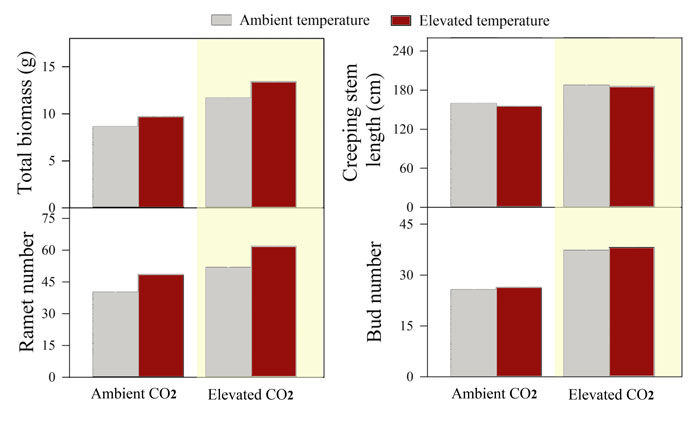| Tweet | Follow @co2science |
Paper Reviewed
Cao, J. and Ruan, H. 2015. Responses of the submerged macrophyte Vallisneria natans to elevated CO2 and temperature. Aquatic Biology 23: 119-127.
Working with Vallisneria natans, a submerged macrophyte that is "widely used in ecological restoration because of its extensive adaptability, high reproductive capacity and high adsorption capacity for pollutants and nutrients," Cao and Ruan (2015) conducted a 60-day study to see how the aquatic plant might fare in a projected CO2-enriched and warmer world of the future, where they grew plantlets they sprouted from buds collected from plants growing in the third largest freshwater lake in China within laboratory mesocosms maintained at water temperatures of either 17.7 or 20.7°C and at atmospheric CO2 concentrations of either 370 or 1000 ppm, while measuring a number of pertinent growth parameters along the way.
This work revealed the maximum photosynthetic rate of the developing plants rose by approximately 29% in the elevated temperature and atmospheric CO2 concentration treatment relative to the ambient temperature and atmospheric CO2 concentration treatment, with the end result that there were associated increases in both total biomass and ramet number, as well as in creeping stem length and bud number (see figure below).

Differences in total plant biomass (per mesocosm), ramet number, creeping stem length, and bud number of Vallisneria natans under different CO2 and temperature conditions. Adapted from Cao and Ruan (2015).
As for the implications of their findings, the two Chinese researchers conclude that "greater resource allocation to creeping stems may allow V. natans to capture more resources, and reduce competition for soil nutrients with neighboring plants," additionally citing Ziao et al. (2006, 2007) and Yan et al. (2006) in this regard. They also note "more buds will likely lead to higher productivity in waters with high CO2 concentrations," all of which expectations bode well for Earth's lakes and rivers.
References
Xiao, K., Yu, D. and Wang, J. 2006. Habitat selection in spatially heterogeneous environments: a test of foraging behavior in clonal submerged macrophyte Vallisneria spiralis. Freshwater Biology 51: 1552-1559.
Xiao, K., Yu, D. and Wang, J. 2007. Benefits of clonal integration between interconnected ramets of Vallisneria spiralis in heterogeneous light environments. Aquatic Botany 86: 76-82.
Yan, X., Yu, D. and Li, Y.K. 2006. The effects of elevated CO2 on clonal growth and nutrient content of submerge plant Vallisneria spinulosa. Chemosphere 62: 595-601.
Posted 17 June 2015



